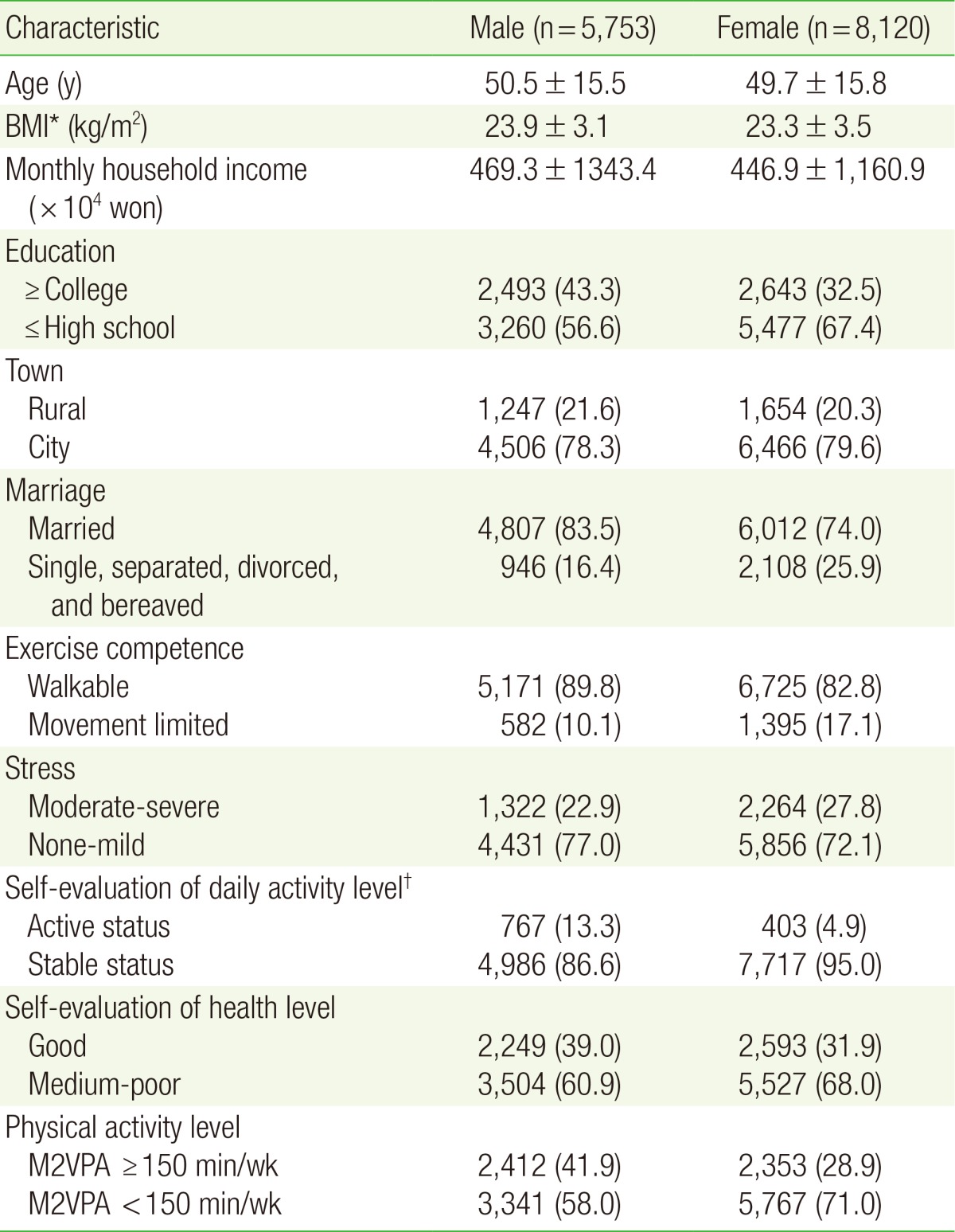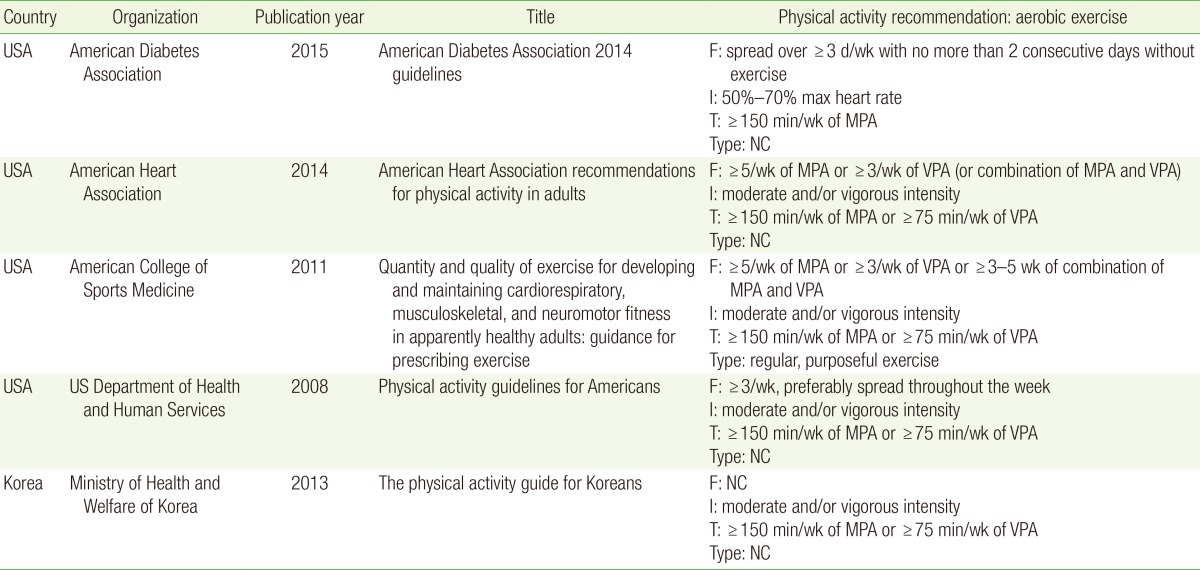1. World Health Organization. Preventing chronic diseases: a vital investment. Geneva: World Health Organization; 2005.
2. Huai P, Xun H, Reilly KH, Wang Y, Ma W, Xi B. Physical activity and risk of hypertension: a meta-analysis of prospective cohort studies. Hypertension 2013;62:1021-1026. PMID:
24082054.


3. Lambert EV, Bull F. Public health recommendations for physical activity in the prevention of type 2 diabetes mellitus. Med Sport Sci 2014;60:130-140. PMID:
25226808.


4. Wen CP, Wai JP, Tsai MK, Yang YC, Cheng TY, Lee MC, et al. Minimum amount of physical activity for reduced mortality and extended life expectancy: a prospective cohort study. Lancet 2011;378:1244-1253. PMID:
21846575.


5. American Diabetes Association. Standards of medical care in diabetes—2015. Diabetes Care 2015;38:S1-S93.

6. American Heart Association. American Heart Association recommendations for physical activity in adults [Internet]. Dallas (TX): American Heart Association; 2014. [cited 2015 Feb 10]. Available from:
http://www.heart.org
7. American Heart Association. Physical activity and exercise recommendations for stroke survivors [Internet]. Dallas (TX): American Heart Association; 2014. [cited 2015 Feb 10]. Available from:
http://www.heart.org
8. Garber CE, Blissmer B, Deschenes MR, Franklin BA, Lamonte MJ, Lee IM, et al. American College of Sports Medicine position stand: quantity and quality of exercise for developing and maintaining cardiorespiratory, musculoskeletal, and neuromotor fitness in apparently healthy adults: guidance for prescribing exercise. Med Sci Sports Exerc 2011;43:1334-1359. PMID:
21694556.


9. US Department of Health and Human Services. Physical activity guidelines for Americans [Internet]. Washington (DC): US Department of Health and Human Services; 2008. [cited 2015 Feb 10]. Available from:
http://www.health.gov/paguidelines
10. Ministry of Health and Welfare of Korea. The physical activity guide for Koreans [Internet]. Sejong: Ministry of Health and Welfare of Korea; 2013. [cited 2015 Feb 10]. Available from:
http://www.mw.go.kr
11. Tucker JM, Welk GJ, Beyler NK. Physical activity in U.S.: adults compliance with the Physical Activity Guidelines for Americans. Am J Prev Med 2011;40:454-461. PMID:
21406280.


12. Yang YJ, Yoon YS, Oh SW, Lee ES. The amount of physical activity of Korean adults measured from the 2001 Korean National Health and Nutrition Survey. J Korean Acad Fam Med 2005;26:22-30.
13. National Health Insurance. Physical activity prevalence rate per a week at 2009-2012 [Internet]. Seoul: National Health Insurance; 2013. [cited 2015 Feb 10]. Available from:
http://sis.nhis.or.kr/site/sis/
14. Evenson KR, Butler EN, Rosamond WD. Prevalence of physical activity and sedentary behavior among adults with cardiovascular disease in the United States. J Cardiopulm Rehabil Prev 2014;34:406-419. PMID:
25068393.



15. Butler EN, Evenson KR. Prevalence of physical activity and sedentary behavior among stroke survivors in the United States. Top Stroke Rehabil 2014;21:246-255. PMID:
24985392.



16. Zhao G, Ford ES, Li C, Balluz LS. Physical activity in U.S. older adults with diabetes mellitus: prevalence and correlates of meeting physical activity recommendations. J Am Geriatr Soc 2011;59:132-137. PMID:
21226683.


17. Bauman AE, Reis RS, Sallis JF, Wells JC, Loos RJ, Martin BW, et al. Correlates of physical activity: why are some people physically active and others not? Lancet 2012;380:258-271. PMID:
22818938.


18. Semlitsch T, Jeitler K, Hemkens LG, Horvath K, Nagele E, Schuermann C, et al. Increasing physical activity for the treatment of hypertension: a systematic review and meta-analysis. Sports Med 2013;43:1009-1023. PMID:
23812856.


19. Rossi A, Dikareva A, Bacon SL, Daskalopoulou SS. The impact of physical activity on mortality in patients with high blood pressure: a systematic review. J Hypertens 2012;30:1277-1288. PMID:
22573122.


20. High BMI and low physical activity are independent risk factors for type 2 diabetes in women. Evid Based Public Health 2005;9:155-156.

21. Kaizu S, Kishimoto H, Iwase M, Fujii H, Ohkuma T, Ide H, et al. Impact of leisure-time physical activity on glycemic control and cardiovascular risk factors in Japanese patients with type 2 diabetes mellitus: the Fukuoka Diabetes Registry. PLoS One 2014;9:e98768PMID:
24897110.



22. Nylen ES, Kokkinos P, Myers J, Faselis C. Prognostic effect of exercise capacity on mortality in older adults with diabetes mellitus. J Am Geriatr Soc 2010;58:1850-1854. PMID:
20929462.


23. Koivula RW, Tornberg AB, Franks PW. Exercise and diabetes-related cardiovascular disease: systematic review of published evidence from observational studies and clinical trials. Curr Diab Rep 2013;13:372-380. PMID:
23494754.


24. Sluik D, Buijsse B, Muckelbauer R, Kaaks R, Teucher B, Johnsen NF, et al. Physical activity and mortality in individuals with diabetes mellitus: a prospective study and meta-analysis. Arch Intern Med 2012;172:1285-1295. PMID:
22868663.


25. Dancy C, Lohsoonthorn V, Williams MA. Risk of dyslipidemia in relation to level of physical activity among Thai professional and office workers. Southeast Asian J Trop Med Public Health 2008;39:932-941. PMID:
19058592.

26. LeBlanc AG, Janssen I. Dose-response relationship between physical activity and dyslipidemia in youth. Can J Cardiol 2010;26:201-205. PMID:
20548982.


27. Kim SR, Han K, Choi JY, Ersek J, Liu J, Jo SJ, et al. Age- and sex-specific relationships between household income, education, and diabetes mellitus in Korean adults: the Korea National Health and Nutrition Examination Survey, 2008-2010. PLoS One 2015;10:e0117034PMID:
25622031.



28. Nayak BS, Sobrian A, Latiff K, Pope D, Rampersad A, Lourenco K, et al. The association of age, gender, ethnicity, family history, obesity and hypertension with type 2 diabetes mellitus in Trinidad. Diabetes Metab Syndr 2014;8:91-95. PMID:
24907173.


29. Komar-Samardzija M, Braun LT, Keithley JK, Quinn LT. Factors associated with physical activity levels in African-American women with type 2 diabetes. J Am Acad Nurse Pract 2012;24:209-217. PMID:
22486836.


30. Sazlina SG, Browning C, Yasin S. Interventions to promote physical activity in older people with type 2 diabetes mellitus: a systematic review. Front Public Health 2013;1:71PMID:
24392445.















